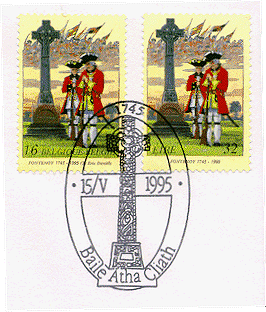
Joint issue with the Belgian Post Office--:

To coincide with the 250th Anniversary of the Battle of Fontenoy, both the Irish and Belgian Post Offices issued a single common design stamp. The stamp, which was designed by Eric Daniels, was printed in Belgium. The Belgian Post Office also issued a special postcard on 15th May 1995 designed in-house by the Belgian Post Office. The joint issue stamp features the monument in the form of a Celtic Cross which was erected as a memorial to all the Irish on both sides who lost their lives in the battle, flanked by two soldiers of the Irish Brigade.
This memorial was erected on the battle site at Fontenoy. Under the terms of the Treaty of Limerick, that ended the Williamite Wars, the Irish troops could either disband, join William’s army or serve in France. Some 14,000 men decided to leave Ireland to serve in the armies of France. These men formed what was to become known as the Irish Brigade or Wild Geese.
The ranks of the Wild Geese were further increased during the period after 1691 when laws were introduced which prevented Catholics serving in the armed forces in Ireland. This resulted in large numbers of Irish leaving to serve in the Irish Brigade in France. In the century 1691-1791 it is estimated that 500,000 men left for France. They eventually disbanded in 1791. During their existence they played decisive roles in two major battles at Cremona in 1703 and Fontenoy in 1745. They also took part in most of the campaigns of Louis XIV and fought at Blenheim, Ramillies and Malphaquet.
The Battle of Fontenoy took place on 11 May 1745, close to the town of Antoing, near Tournai in what is nowadays the Kingdom of Belgium. Austria, Russia, The Netherlands and Great Britain were leagued against Prussia, Spain and France in the War of the Austrian Succession (1741 –1748), and the battle of Fontenoy, in which the Martechal de Saxe was victorious over the Anglo-Dutch forces under the Duke of Cumberland, reflected Anglo-French rivalries in the New World.
The decisive turning point of the Battle of Fontenoy was the intervention of the Irish troops in the service of Louis XV of France with their battle cry of "Remember Limerick". Their delight at defeating the British was shortlived when they heard about the slaughter of their fellow Irishmen on the other side. A special tune "St Patrick’s Day" in commemoration of the Irish who died on both sides was played as night fell on the battlefields.
At Fontenoy a monument stands in the form of a Celtic Cross to all the Irish who lost their lives. It is written in French and Gaelic remembering also the British violation of the Treaty of Limerick guaranteeing freedom of religion.